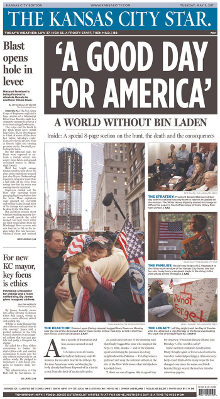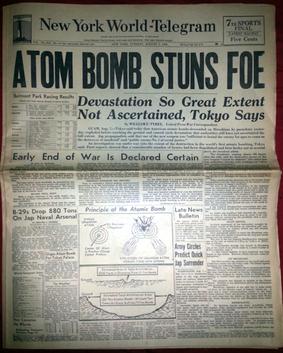
The Kansas City Star is a newspaper based in Kansas City, Missouri. Published since 1880, the paper is the recipient of eight Pulitzer Prizes.

The New York World-Telegram, later known as the New York World-Telegram and The Sun, was a New York City newspaper from 1931 to 1966.

The New York World was a newspaper published in New York City from 1860 to 1931. The paper played a major role in the history of American newspapers as a leading national voice of the Democratic Party. From 1883 to 1911 under publisher Joseph Pulitzer, it was a pioneer in yellow journalism, capturing readers' attention with sensation, sports, sex and scandal and pushing its daily circulation to the one-million mark. It was sold in 1931 and merged into the New York World-Telegram.

The Pittsburgh Dispatch was a leading newspaper in Pittsburgh, operating from 1846 to 1923. After being enlarged by publisher Daniel O'Neill it was reportedly one of the largest and most prosperous newspapers in the United States. From 1880 to 1887 native of nearby Cochran's Mills, Nellie Bly worked for the Dispatch writing investigative articles on female factory workers, and later reported from Mexico as a foreign correspondent. The paper was politically independent and was particularly known for its in-depth court reporting.
The Newspaper Preservation Act of 1970 was an Act of the United States Congress, signed by President Richard Nixon, authorizing the formation of joint operating agreements among competing newspaper operations within the same media market area. It exempted newspapers from certain provisions of antitrust laws. Its drafters argued that this would allow the survival of multiple daily newspapers in a given urban market where circulation was declining. This exemption stemmed from the observation that the alternative is usually for at least one of the newspapers, generally the one published in the evening, to cease operations altogether.
The Birmingham Post-Herald was a daily newspaper in Birmingham, Alabama, with roots dating back to 1850, before the founding of Birmingham. The final edition was published on September 23, 2005. In its last full year, its average daily circulation was 7,544, down from 8,948 the previous year.

Frank Andrew Munsey was an American newspaper and magazine publisher, banker, political financier and author. He was born in Mercer, Maine, but spent most of his life in New York City. The village of Munsey Park, New York, is named for him, along with The Munsey Building in downtown Baltimore, Maryland, at the southeast corner of North Calvert and East Fayette Streets.
The East Valley Tribune is a newspaper concentrated on cities within the East Valley region of metropolitan Phoenix, including Mesa, Tempe, Chandler, Gilbert, and Queen Creek.

The Idaho Press of Nampa, Idaho is the second-oldest active newspaper in Idaho, first printed in December 1883. In its early years, the newspaper was often an instrument of political influence. One of the first owners and editors was Frank Steunenberg.

The Chicago Daily Journal was a Chicago newspaper that published from 1844 to 1929.
The Cleveland News was a daily and Sunday American newspaper in Cleveland, Ohio. It was published from 1905 until 1960 when it was absorbed by the rival paper The Cleveland Press.

The Indianapolis Freeman (1884–1926) was the first illustrated black newspaper in the United States. Founder and owner Louis Howland, who was soon replaced by Edward Elder Cooper, published its first print edition on November 20, 1884.
KPC Media Group Inc. is an American privately owned printer and publisher of daily and weekly newspapers, based in Kendallville, Indiana.

The South Bend News-Times was a daily newspaper in South Bend, Indiana, in the United States, from 1913 to 1938.

The Indianapolis Leader began in August 1879 as Indianapolis' first black newspaper.
The Vincennes Sun-Commercial is a newspaper in the city of Vincennes, Indiana, United States. It is currently a member of the Hoosier State Press Association. The newspaper was originally created by Elihu Stout in 1804, and is the first newspaper in the state of Indiana. In 2004 the Vincennes sun-commercial was recognized by the Indiana General Assembly House of Representatives on the occasion of the 200th anniversary of its founding.
The Journal Review is a newspaper based in Crawfordsville, Indiana, USA with a circulation of 6,000. It is a daily except Sunday paper and reports national news and news for the surrounding Montgomery County area in print and online. The paper was founded in 1929 as an independent daily from the merger of the Journal and the Review. This small town newspaper has chronicled multiple notable events.

Minnie Thomas Boyce was an American writer.













